Beth Kephart's Blog, page 74
August 26, 2014
upcoming, open, and free: September 4/rivers, gardens, ghosts/Radnor Memorial Library

The talk is written.The doors will be open.Rivers. Gardens. Ghosts.Radnor Memorial LibrarySeptember 4, 2014




Published on August 26, 2014 11:08
August 25, 2014
baby steps/finding our way toward new projects
 In Adamstown yesterday, I buy this pair of 19th century shoes. I bring them home. I add them to my small collection. I like the scars and worn buttons. I like imagining the child who yearned to run.
In Adamstown yesterday, I buy this pair of 19th century shoes. I bring them home. I add them to my small collection. I like the scars and worn buttons. I like imagining the child who yearned to run.Which is precisely what I've been doing lately—imagining, yearning. We need time, I always think, between projects. We can't leave one thing and rush to another. I never have, never do. We have to figure out who we have become in the midst of making and who we are going to be next. We have to believe in the validity of our own work, its place in things. Write as if you are writing your last book, I always tell myself. Because someday it will be your last book.
I will want to believe that it mattered.
And so I buy a pair of shoes and study the scars. I turn stories over in my mind. Yes? No. What? For whom? What is going to matter now?
If no one but me reads the books I write next, will I still believe they were worth making?
They have to be.




Published on August 25, 2014 15:06
August 23, 2014
That someone who could change your life—Powers of Two: Finding the Essence of Innovation in Creative Pairs/Joshua Wolf Shenk
 This weekend's New York Times Book Review fills me with desire. I imagine a lake house. I imagine time. I imagine a week with nothing but books and a notebook into which I might record my favorite lines.
This weekend's New York Times Book Review fills me with desire. I imagine a lake house. I imagine time. I imagine a week with nothing but books and a notebook into which I might record my favorite lines.Alas.
That isn't here, or now. And so I find myself reading the first many chapters of the reviewed books instead, trying to narrow my choices for those days when I will have full reading time. In Joshua Wolf Shenk's Powers of Two, reviewed by Sarah Lewis, I find this bit of loveliness. I am, to be honest, a lone wolf much of the time—searching my limited brain for a next idea, having the conversation mostly in private, taking the long solo walk to breathe more substance in.
But there have been moments, projects, abbreviated eras when I've found myself in the midst of a heady collaboration. Someone who makes the small idea bigger or clearer than how it began.
Shenk captures the feeling of that here:
When the quickening comes. When the air between us feels less like a gap than a passage. When we don't know what to say because there is so much to say. Or, conversely, when we know just what to say because somehow, weirdly, all the billions of impulses around thought and language suddenly coalesce and find a direction home.
Sometimes you meet someone who could change your life. Sometimes you feel that possibility. The sense that, in the presence of this celestial body, you fall into a new orbit; that the ground beneath you is more like a trampoline; that you may be able—with this new person—to create things more beautiful and useful, more fantastic and more real, than you ever could before.
How does this happen? What conditions of circumstance and temperament foster creative connection? In other words: Where and how does it begin? And which combinations of people make it most likely?




Published on August 23, 2014 15:04
August 22, 2014
Scenes of Hamlet—my husband's book of ceramics and still lives (now live on Blurb)
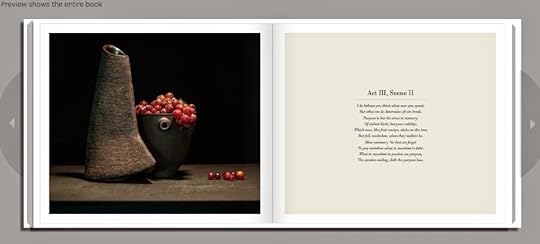 A few days ago I posted here about my husband's work as a ceramicist and photographer.
A few days ago I posted here about my husband's work as a ceramicist and photographer.I can now share that exquisite work here. Bill made all of the pots, arranged, lit, and took the photographs, and designed the book, which he will soon be sharing with ceramics studios.
I, however, love the work so much that I have asked if I might share it with all of you.
The link to the Blurb book preview is here.
In a few weeks I'll be sharing Bill's new web site, which features this work, his 3D design work, and his photography.




Published on August 22, 2014 13:15
How to Tell Toledo from the Night Sky/Lydia Netzer: Chicago Tribune Review
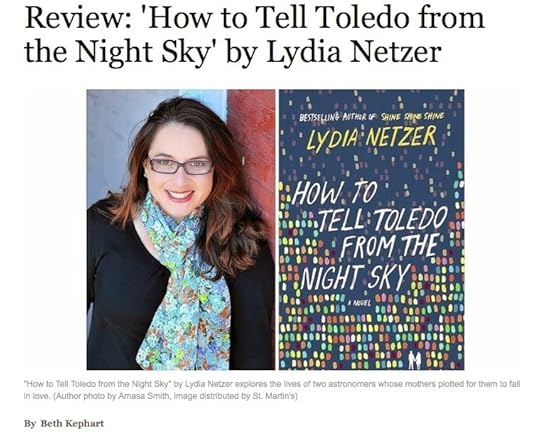 I want to love every book I read. I crack the spine eager with hope. I struggled, unfortunately, with Lydia Netzer's new novel, a book that has elsewhere earned raves as well as raised eyebrows.
I want to love every book I read. I crack the spine eager with hope. I struggled, unfortunately, with Lydia Netzer's new novel, a book that has elsewhere earned raves as well as raised eyebrows. My review of the book is now live in Printers Row Journal. It begins like this, below, and can be read in its entirety here.
If you are a reader intoxicated by the strange, a reader for whom conceits matter more than characters and song, then Lydia Netzer's "How to Tell Toledo From the Night Sky" is the sort of book that may well live up to its billing as a funny valentine. If, on the other hand, you read in search of stories that ultimately transcend ideas, then this second novel by the best-selling author of "Shine Shine Shine" may furrow your brow.




Published on August 22, 2014 04:27
August 21, 2014
Honoring Greg Djanikian in the pages of the Pennsylvania Gazette
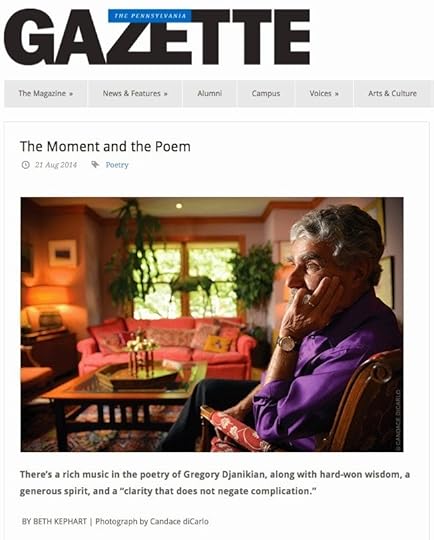 I felt blessed when Pennsylvania Gazette editor John Prendergast invited me to write a 3,000 word story about Greg Djanikian, who trusted me to teach at Penn, who talks with me many spring-semester Tuesdays when I arrive early to teach, who inspired a key character in my forthcoming Florence novel One Thing Stolen, and who writes some of the most gorgeous poetry anywhere. I wrote of his most recent book, Dear Gravity, here.
I felt blessed when Pennsylvania Gazette editor John Prendergast invited me to write a 3,000 word story about Greg Djanikian, who trusted me to teach at Penn, who talks with me many spring-semester Tuesdays when I arrive early to teach, who inspired a key character in my forthcoming Florence novel One Thing Stolen, and who writes some of the most gorgeous poetry anywhere. I wrote of his most recent book, Dear Gravity, here.To write this story I spent an afternoon in Greg's beautiful home (filled with the artistry of his wife), interviewed Stephen Dunn, Julia Alvarez, Al Filreis, Gerald Costanzo, Fred Muratori, and others, and returned to a dear student, Eric Xu, who brought valuable insights to the Greg's beloved teaching.
The story can be found here.




Published on August 21, 2014 11:52
August 20, 2014
Leah Apple, my beautiful student, shares her dance as a Fulbright Scholar on the island of Kinmen
The great privilege of teaching extraordinary students is that the semester of writing, reflection, and talk marks only the start of an involving conversation.
Last evening, Leah Apple, the hip-hop dancing Fulbright winner who enrolled in my second nonfiction class at Penn and whom you met here in a Philadelphia Inquirer story, came for dinner, bringing with her tales of her time in Kinmen, near the People's Republic of China. In a remote niche of that island, Leah met and taught English to children with whom she soon fell in love. Inevitably, they fell in love with her. Dance, "the universal language," became core to Leah's curriculum as she and her fellow Fulbright scholars prepared the children for a first-ever island flash mob.
This short film, shot and produced by Leah's friend Jonah Stern, tells the story of remote classrooms, willing children, and a young woman with a boundless soul.




Published on August 20, 2014 03:40
August 19, 2014
Meera Lee Patel: gift upon gift
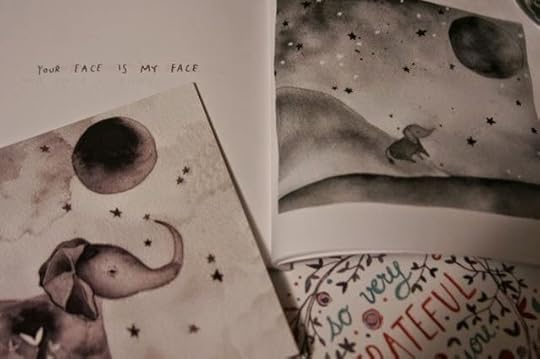 Not long ago I posted here about an extremely gifted artist, Meera Lee Patel, whose delicate and soulful renderings of atmospheric worlds grace tea towels and greeting cards, tote bags and journals, even slingy chairs. You can find her work on Etsy and in Free People. You can follow her musings over Twitter, her process sketches on Instagram, her hope for the world in every line she draws, and next year Perigree Books will be releasing her book Being Me (But Better). I can't actually imagine a better Meera Lee, but I'm eagerly anticipating her book.
Not long ago I posted here about an extremely gifted artist, Meera Lee Patel, whose delicate and soulful renderings of atmospheric worlds grace tea towels and greeting cards, tote bags and journals, even slingy chairs. You can find her work on Etsy and in Free People. You can follow her musings over Twitter, her process sketches on Instagram, her hope for the world in every line she draws, and next year Perigree Books will be releasing her book Being Me (But Better). I can't actually imagine a better Meera Lee, but I'm eagerly anticipating her book.Yesterday, as a cadre of painters and window caulkers and windowsill fixers and stucco men finished the rescue of my modest bungalow home, a gift arrived from Meera, a package of most precious things. Number 37 of 50 of her keepsake Elephant and Moon (her illustrated story of an elephant seeking his place in the world). A handmade card: Grateful. A postcard. Her long-lettered words to me. She is so utterly embrace-able, this Meera Lee. And I am enormously lucky to have her in my life.
For look, above, at what she makes.
Soon, here, you'll find another inimitable work of art from Meera Lee, for Chronicle Books had the extraordinary stroke of genius to hire her as the cover artist for One Thing Stolen, the Florence novel due out next April. I've not yet seen the final cover. I have seen the intricate, intelligent watercolor. I can't wait to hold this book in my hand, for Meera's reading of the novel was so astute; her discovery of the small details make her cover illustration sing.
One Thing Stolen, which has a rare neurological disease at its heart, was not an easy book to write; it was, in fact, heartbreaking as I imagined myself inside the mind of frightened young girl. It emerged out of many drafts and deep considering. I stumbled until at last I found the light, and then I waited. Before I'd even seen a glimpse of Meera's cover art, I'd heard from Meera—words from a reader that will always matter to me.
Gift upon gift upon gift. And then yesterday's package.
When the cover art is ready for sharing, you will find it along with an interview with Meera here. Between now and then, Meera, the atmosphere is, as you write in Elephant and Moon, "feelings and fabrics from lifetimes before."




Published on August 19, 2014 04:37
August 18, 2014
returning to failed projects so that I might understand the failures
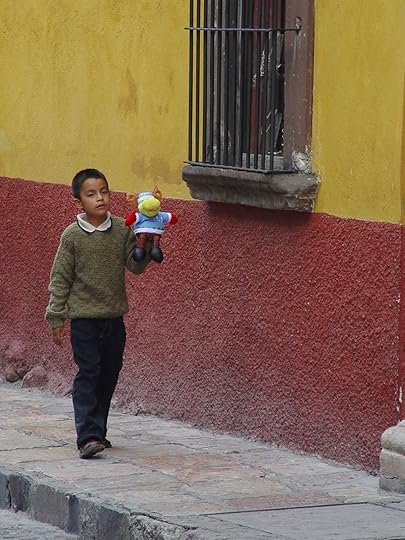 In between reading and thinking, cleaning and restoring the house, and trying new recipes out on friends who accept the dare, I am reading the work of yesteryears—the pages upon pages that were never published. What went wrong? What must I not do again as I ponder the possibility of new stories?
In between reading and thinking, cleaning and restoring the house, and trying new recipes out on friends who accept the dare, I am reading the work of yesteryears—the pages upon pages that were never published. What went wrong? What must I not do again as I ponder the possibility of new stories?Sometimes I find passages, written as fiction, that return me to real life. Here is a boy and the paragraph I wrote for him inside a novel I never published. The place is San Miguel.
<!-- /* Font Definitions */ @font-face {font-family:Cambria; panose-1:2 4 5 3 5 4 6 3 2 4; mso-font-charset:0; mso-generic-font-family:auto; mso-font-pitch:variable; mso-font-signature:3 0 0 0 1 0;} /* Style Definitions */ p.MsoNormal, li.MsoNormal, div.MsoNormal {mso-style-parent:""; margin:0in; margin-bottom:.0001pt; mso-pagination:widow-orphan; font-size:12.0pt; font-family:"Times New Roman"; mso-ascii-font-family:Cambria; mso-fareast-font-family:Cambria; mso-hansi-font-family:Cambria; mso-bidi-font-family:"Times New Roman";} @page Section1 {size:8.5in 11.0in; margin:1.0in 1.25in 1.0in 1.25in; mso-header-margin:.5in; mso-footer-margin:.5in; mso-paper-source:0;} div.Section1 {page:Section1;} </style> --> <br /><blockquote class="tr_bq"><div class="MsoNormal" style="line-height: 200%; text-indent: .5in;">Nothing was neutral in San Miguel.<span style="mso-spacerun: yes;"> </span>The place was full of opinions—the murmur of fountains behind padlocked doors, the inscription of grills high on windows, the casual flamboyance of the mariachi men, the coruscation, in the distance, of abandoned mining towns.<span style="mso-spacerun: yes;"> </span>The lintels above the ornate doors were carved with news of vanished families, rose spires pierced the sky, the smoke of the <i style="mso-bidi-font-style: normal;">helotes</i> carts was weather, and every day a boy wearing a yellow cabled sweater and shiny shoes carried a moose puppet across the cobbles of the town.</div></blockquote><blockquote class="tr_bq"> “Where do you think he’s going?"<br />“I don’t know.”<br />“What do you think he wants?”<br /> “Air.”</blockquote><br />The failure here? The static quality of the dialogue. Too much like a poem, which is not how real people speak. <div class="feedflare">
<a href="http://feeds.feedburner.com/~ff/BethK... src="http://feeds.feedburner.com/~ff/BethK..." border="0"></img></a> <a href="http://feeds.feedburner.com/~ff/BethK... src="http://feeds.feedburner.com/~ff/BethK..." border="0"></img></a> <a href="http://feeds.feedburner.com/~ff/BethK... src="http://feeds.feedburner.com/~ff/BethK..." border="0"></img></a> <a href="http://feeds.feedburner.com/~ff/BethK... src="http://feeds.feedburner.com/~ff/BethK..." border="0"></img></a>
</div>
Published on August 18, 2014 04:42
August 17, 2014
Richard Bausch on sophisticated fiction
 In today's Printers Row Journal, Kevin Nance interviews Richard Bausch about his new novel, Before, During, After. Complexity, Bausch suggests, separates serious fiction from other forms of entertainment. And I think, yes. Complexity. That's the word.
In today's Printers Row Journal, Kevin Nance interviews Richard Bausch about his new novel, Before, During, After. Complexity, Bausch suggests, separates serious fiction from other forms of entertainment. And I think, yes. Complexity. That's the word.Q: The other intersection between public and private history in “Before, During, After” is indicated in the title. There’s a way in which these great calamities that happen — in my parents’ generation it was the Kennedy assassination, in my own generation it was 9/11 — seem like points of demarcation, watershed moments that define “before” and “after.”
A: Yes, and it has to do with the discovery of complexity and the fact that there’s evil in the world — things that no amount of study or work or will or effort can change one bit, and we just have to somehow live with it. I think that’s what separates serious, sophisticated fiction from more trivial kinds of entertainment — although it all had better entertain or it’s a failure, no matter what its intent.
It’s all honorable and good, I should say; there’s no such thing as fiction writing that’s immoral — I don’t believe that at all. If it diverts and tells a story that involves the reader, it’s a good thing. If it’s boring, that’s different, but that’s another kettle of fish that has nothing to do with what the activity really is. I mean, Stephen King, who’s begun to get some cachet as the excellent storyteller that he is, used to be dismissed out of hand as some sort of hack. But if you read the guy, he can write like hell. There’s an aspect of what he does that could be defined as genre writing, but even that shows real thought and real intention, and people are starting to notice that.




Published on August 17, 2014 05:24



